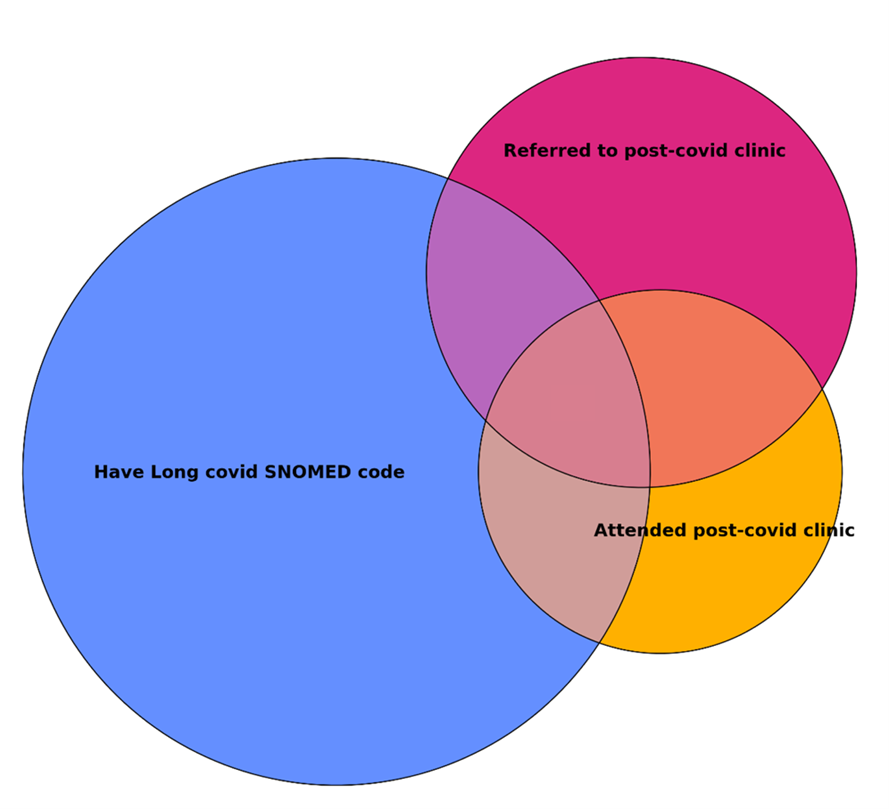Using healthcare records to understand Long COVID diagnosis and treatments
Long Covid: How healthcare records are helping us to understand diagnosis and treatments
By Dr. Jonathan Clarke, Denys Prociuk, Nikki Smith, and Ruairidh Milne
What are we doing?
Work is well under way in Workstream (WS) 3.1 of the LOCOMOTION Study, which was one of the studies funded by the NIHR as part of approximately £20m provided for research into Long Covid.
We have people with Long Covid working with us – in fact the idea for this update came from them and has been written with them – to ensure the work we carry out remains relevant to the care of people with Long Covid and we do not miss anything important.
In WS3.1, we are using data from healthcare records to analyse Long Covid diagnoses, to see what healthcare, people are getting and how this varies over time, including both before and after a Long Covid diagnosis. We can also see in the records, information on Covid-19 test results, vaccinations, and general information such as age and ethnicity.
Some of the datasets we have, have not been used for research before while others have been created specifically for the project.
We have records from GPs, Long Covid Clinics, and hospitals, from millions of people. So there is a lot to look at, and you wouldn’t believe how long it’s taken for us to get hold of the data, especially as it all had to be anonymised first!

Lots of Data!
The two, quite different sets of data we are using are called:
In the datasets that we’ve got, we can’t see the text that has been typed by doctors and other healthcare staff. Instead we rely on clinical codes, which are combinations of numbers and letters that indicate whether a patient has, for example, been referred to a certain specialist, has had a particular diagnosis, or received a treatment.
The WSIC data alone is from over two million patients in North West London. This data gives us a good understanding of how patients with Long Covid interact with the NHS. But, it is limited to North West London.
In contrast, ORCHID brings together data from almost 2,000 GP practices across England, and will allow us to learn a lot more about who is being diagnosed with Long Covid and when. However, it can’t tell us as much about what is going on in hospitals and clinics.
But, together, these two datasets allow us to answer several important questions!

So, how well is Long Covid recorded in medical records?
Long Covid is a relatively new condition, in medical terms at least. At the start of the Covid-19 pandemic, clinical codes needed to be developed so that these new conditions could be properly recorded in patients’ medical records.
It wasn’t until January 2021 that clinical codes relating to Long Covid became available for the NHS to use, so there were lots of people who had already been experiencing Long Covid for many months before these codes existed.
Also, the codes that doctors have been using to record Long Covid have gone through some changes since the codes were brought into use.
We also have to bear in mind that just because a clinical code is available, it doesn’t necessarily mean that it will be used!
This can all make it difficult for us to find all the information we want about Long Covid in people’s medical records.
We are therefore looking at which codes have been used to represent a Long Covid diagnosis and how coding practices have changed over time.
We will also be able to see from the WSIC data how many patients have been referred to a Long Covid clinic, have had an appointment with a Long Covid clinic, or have received a Long Covid diagnosis.
Looking at the overlap between these three groups will help us to better understand how medical records may be missing some Long Covid diagnoses and what this means for the other work we are doing.

How else can we identify who may have Long Covid?
Due to the problems with Long Covid not always being accurately recorded in health records, we are also looking at another way of using information in the records to figure out who else may have Long Covid without having a Long Covid code.
As there are clinical codes for lots of different symptoms, and we know which symptoms can be common in Long Covid, for example breathlessness and fatigue, we are seeing if we can identify other people with Long Covid by looking at which symptom codes have been added to their medical records.
How does Long Covid relate to other medical conditions?
Within the WSIC and ORCHID datasets, we are able to look at which other medical conditions patients have been diagnosed with.
This will enable us to determine whether certain conditions are more common in patients with Long Covid.
This will help us identify potential risk factors for Long Covid and help better understand the medical needs of patients.
How ‘joined up’ is hospital care for patients with Long Covid?
We understand that the diagnosis of Long Covid and any related care and treatment may involve appointments across a range of medical specialities, and even different hospitals.
We are using the WSIC dataset to investigate which hospital specialists commonly see patients with Long Covid, both before and after their diagnosis.
We are also exploring continuity of care, to better understand how ‘joined-up’ Long Covid care is and what this might mean for patients.
So what happens after?
For each of these questions, it is crucial that what we learn is used to help patients with Long Covid. This could include sharing our findings with Long Covid Clinics, decision makers in the NHS, and with NICE – The National Institute for Health and Care Excellence – to help inform those working in healthcare and organisations that fund research.
We will also share our findings with as wide an audience as possible, and beyond the usual routes of publishing in academic journals, including running public webinars.
The LOCOMOTION Study was originally designed with the help of several people experiencing Long Covid. Their involvement has continued throughout the study and will remain at the heart of WS3.1!
